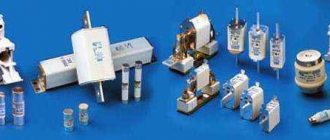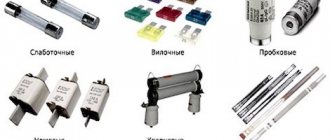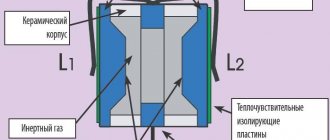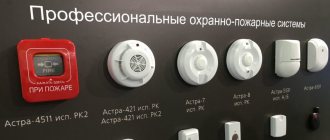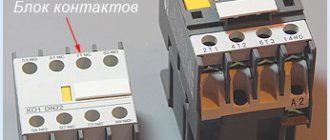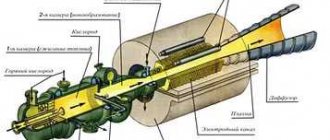Fuses, their purpose, types, types, structure are important to know for the effective use of electrical appliances; this is one of the types of protective devices against overcurrents and short circuits. The fuse insert “sacrifices” itself - it burns out, opening the power circuit. The filling of the protected object remains undamaged and to bring it into working condition you only need to replace the conductor. If the device fails, this does not mean a significant breakdown - perhaps the fuse has simply blown. Replacement is simple: you need to place a new insert in the holder or solder a new PCB.
What are fuses
For the electrical network, there are several protective devices that respond to dangerous factors by opening the circuit; they can create many stages. Traditionally, automatic shutdown devices are installed in panels and on consumer lines - AV, RCD+AV, RCBO, sometimes such devices are mounted directly on the power cords (cable RCD, typical for water heaters). But there are also simpler and cheaper elements - fuses, inserts.
Device, appearance
A fuse is a glass/ceramic/fiber cap (insert) at the ends with metal caps, a box, a flag with a wire on electrical device boards, in ASUs, plugs. It is inserted into a seat (holder) with metal clamps or like a socket, and soldered. In fact, this is a wire that connects a circuit, but with special parameters.
Everyone knows that if the cross-section of the wiring is not designed for the power of the switched on electrical appliances, then it overheats and can burn out; the same principle is the basis of the PCB.
Inside the insert there is a conductor (wire, wire, plate) made of metals and their alloys (copper, zinc, steel) necessarily connected to the circuit through contacts at its two ends. In small devices, the element does not exceed the size of a microcircuit part. There are also large devices - boxes with sides of several cm, with thick fusible plates inside, designed for thousands of amperes (PPN-37.41).
The form may also have a socket connection like a plug, but the principle is the same. There are also standard sizes without a seat, that is, solid ones, in which the insert is not replaceable; such a PCB changes completely along with it.
Case materials: composite, ceramics, glass, fiber. There may be filling inside (quartz chips for extinguishing the electric arc), which is typical for powerful varieties of PP.
Relay VAZ 2106
The following shows the location and designation of each factory relay:
- Voltage regulator, which is responsible for proper charging of the battery. Located on the left mudguard.
Battery charge voltage regulator relay - Turning on the radiator cooling fan. It is also located on the left mudguard, behind the expansion tank.
Radiator fan relay - A light on the dashboard that indicates battery charging. The relay is already located on the right mudguard.
Battery charging light relay - Low and high beam headlights. They are also located on the right mudguard. They are identical and interchangeable.
Relay for low and high beam headlights - Turn and hazard warning relay. It is located behind the instrument panel, approximately behind the tachometer.
- The wiper relay is located on the left side, under the instrument panel.
The video below clearly shows where which relay is located.
How does a fuse work?
Triggering occurs through the combustion of a fuse-link: when the current exceeds the permissible value, a temperature effect is created - the element burns out, thereby the contacts are disconnected, and the equipment is de-energized. The same is true for short circuits. The process takes a split second. There are different disconnecting conductors (more or less sensitive) for specific temperatures and loads.
The difference between PP and automatic machines and RCDs: after activation, the insert or the entire element must be replaced. The advantage is that it is cheap and easy to replace: you just need to snap on a new insert, place a new copy in the socket, or, less often, solder it.
PCB protection is based on the ability of metals to overheat when current exceeding their carrying capacity passes through them. If the parameters match, the metal is heated evenly—the heat has time to dissipate. When the value exceeds the permissible level - a thin wire, the plate inside the flask melts and collapses. Moreover, this happens almost instantly.
What are fuse links used for:
- overload protection (bursts, surges);
- from short circuit.
In addition to protection, the operation of the PP will indicate problems, breakdowns, and equipment defects, for example, those that caused a short circuit.
Schematic designation
In diagrams and drawings, the PP is designated as follows:
- a rectangle with a horizontal straight line crossing it in the middle. The ends are connected to the circuit;
- according to foreign standards, other graphic designs can be used: according to IEC - a rectangle with designated segments;
- according to IEEE/ANSI - wave.
Description of fuse options and fuses
Types:
- with filling (PN-2, PPN, NPN). An internal cavity filled with materials that extinguish the electric arc that appears during burnout. The circuit is open only when this phenomenon disappears. The extinguishing agent is quartz dust;
- without filling (PR-2). The arc is suppressed by the gas released during activation and heating of the walls of the insert. Low-current PPs may not have this and the previous feature.
Kinds:
- tubular and low current. The first are glass, ceramic or fiber cylinders with clamps at the ends. The second ones are the same, but more often with a glass bulb, for low-power household devices up to 6 A. The insert snaps into a horizontal longitudinal holder with clamp terminals, its metal ends touch the contacts on the cylinder (clamps), thus the product is included in the circuit. Such varieties are usually unfilled, especially if they are fiber: this material, when heated, releases gas to suppress the arc;
- fork Typically for automotive equipment, for units with PCB on control panels. The contacts resemble a plug and are located at the bottom;
- fuse plugs or cork fusible inserts. Standard for 63 A. Serves one-time operation of household consumers. The part that burns out is hidden by ceramics with a cartridge; there is 1 contact on the outside, the other is connected to the plug. The PP burns out, cutting off power to the apartment. Restore power supply by replacing the insert. Such devices were installed in houses of old buildings, but are now used less frequently, since there are AV and RCD. Remain relevant in power plants and industry;
- knife For 100 - 1250 A, used for high values, for example, in the presence of powerful electric motors, in ASU;
- quartz, with quartz dust inside - for values up to 36 kV;
- gas-generating (with or without the possibility of disassembly). When burning (flash), popping noise and intense gas emission occurs (models PSN, PVT). For 35–110 kV. Rating up to 100 A
Selection of fuse link and fuse
The choice is influenced by:
- network load is the main parameter for selection. This determining factor also affects whether the PCB will be filled, the material of its insert, the parameters (thickness, alloy) of the conductor;
- standard size and installation method. The PP is selected to fit the seat available on the equipment (plug, longitudinal structure with terminals). Installation by simple insertion or soldering (on microcircuits).
More powerful PPs are installed in transformer units with currents for groups of apartment buildings and enterprises. Low-power - near meters, to protect individual apartments. Low-current in the form of small flasks - in household appliances, on their circuit boards. At the moment, they are not always relevant in modern technology, but a special type - integrated ceramic SMD fuses - is always available (their disadvantage is the difficulty of replacement).
Calculation
To determine the appropriate fuse ratings, consider the following:
| Parameter | Description |
| Denomination | The current value that can be withstood until failure. It is written on the case, in the documentation. |
| Time-current characteristic | Response speed. Calculate using charts and graphs. For household types, calculation is not necessary if there are low-current PPs. For enterprises with electric motors and other powerful power plants, calculations are always made. In this case, the starting value of the most powerful object is fundamental. |
| Load | Total (maximum), total power of all connected, simultaneously operating consumers on the serviced PP line. The value is equal to all operating currents of the equipment. If there is an electric motor in the circuit, then take into account its starting parameter (current), divided by a certain coefficient:
|
Rules for choosing a denomination:
- equation for calculus: I pp>1/k (I total + I start);
- the rating must exceed the value obtained from current calculations;
- it is convenient to use the table. fixed data will be sufficient as it displays accurate information.
An example of how to calculate the rated power supply for a residential network: add up the power of all consumers (electrical appliances) in W (1 kW is 100 W) and look in the table to see what value (A) of the fuse rating it corresponds to. It is advisable to add a margin of about 20%. If the value is between the end digits of the range, then select the next ascending position.
The calculation described above is suitable for all household purposes, but for enterprises with equipment with powerful starting currents, electric motors, and for power supply systems serving entire houses, you will need to familiarize yourself with the diagrams of temporary starting values.
It should be said that PPs are not used in the control panels of modern apartments, there is simply no point in this - automatic protective shutdowns (AV, RCD, RCBO) are abundant, and its options are much expanded. But in house ASUs they are always there. Also, products are more often found in electrical circuits, in cars, at stations, and in powerful industrial equipment. As a standard, they are present on control panels (alarms, devices with relays, etc.).
Calculation of wire diameter (insert plate, conductor)
Calculating the diameter of the PP conductor and replacing it is rarely done, but it is possible: when there is no new element (insert) to replace the burned out old one and when the design of the product allows the insertion of a plate or wire.
The wire cross-section of the “bug” is selected to match the rating of the burnt insert. For apartments, a 63 A PP is installed as standard; copper ∅ 0.9 mm is suitable.
Calculus in detail:
- Look at the rating of the PP (case, documentation).
- Measure the ∅ of the wiring (with a digital caliper).
- The result is cubed and a square is extracted from the result. root, multiplied by 80.
- Result: we get a figure equal to the nominal value of the PP. The result is approximate, but as close as possible to exact.
The selected wire is wound onto the contacts (terminals) of the burnt insert, connecting them, continuing the circuit. The “bug” is placed in the fuse socket, placed between the terminals at the ends, or inserted like a plug.
Re-melting of the core means a problem in the protected object or network (the current value is higher than their capabilities). There is a risk: if the wire selected is thicker, it will not react to breakage. That is, the malfunction is not diagnosed, the serviced object will continue to work with overloads, which will lead to its failure, this is also fraught with fire and electric shocks.
Power calculation
The fuse link is selected so that it melts before the temperature of the line wires reaches a dangerous level or the overloaded consumer fails. Based on their design features, there are plate, cartridge, tube and plug fuses. The current strength for which the fuse-link is designed is indicated on its body. The maximum permissible voltage at which the fuse can be used is also specified.
It will be interesting➡ The principle of operation of a self-resetting fuse
This curve is measured experimentally: a batch of identical fuses is taken, which are sequentially burned at different currents. The time after which the insert burns out and the current passing through the insert are measured. Each current corresponds to a certain burnout time of the insert. Based on these data, a time characteristic is constructed.
Probably all of us have seen the ceramic “plugs” that are wrapped in the electric meter panel. Until recently, and sometimes even now, they still serve as protection devices. From personal experience - I have repeatedly encountered this connection scheme - there are two plugs in the panel, one is in the phase wire, the second is in the neutral wire. But what kind of switching scheme is categorically incorrect! Under no circumstances should a fuse be connected to the neutral wire. After all, what happens if it fails - the circuit will break down and will be protected, but consumers will still be under the network potential - the phase is present. And these are issues of electrical safety.
Fuse made in the USSR.
Despite the fact that fuses have served their purpose and become obsolete as protection devices in household bushings, throughout their existence they have adequately performed this function. Fuses, of course, cope with their functions of protecting against excess current consumption or short circuit. However, today, especially in the household sector, fuse links are becoming a rarity.
Plus, these are quite dangerous devices in terms of fire. After all, today many consider themselves electricians, and when the “plug” burns out, some “specialists” install “bugs” from uncalibrated wire. And, sometimes, quite exotic. I described a typical example in the previous review. And what all this entails - you don’t need to go far - look at the chronicle of the emergency on any TV channel. Therefore, it is quite natural that fuse-links have been replaced by more reliable devices - circuit breakers.
How to check functionality
The main thing is to determine whether there is a gap. Some types of fuses (often automotive) have a built-in blow indicator. In low-current versions, the wire is visible through the glass flask (if it is broken, then the product is not working).
There are PP options with opaque inserts, cases made of polymers, fiber, ceramics and without indicators. You can diagnose a break with a multimeter:
- Resistance measurement mode (the letter “omega” on the scale, select the minimum value). Probes - to contacts: at “0” or indicators close to it - operability; 1 or infinity sign - the insert is burnt out, there is a gap.
- Dial mode: zero (close to zero) or numbers - operability, if there is a buzzer option, the tester will emit a squeak; 1 - break.
Safety resistor
A safety resistor is a special case of a conventional fuse link. It looks and behaves like a regular resistor - it has a certain resistance, tolerance and permissible power dissipation. Fusible resistors are often made in the form of radio elements with a permissible power of 0.5 W, 1 W or 2 W.
They differ from conventional resistors in that when the permissible power is exceeded, they burn out and cut off the current in the circuit without creating a fire hazard (they do not ignite themselves and reliably disconnect the circuit - which is not obvious in the case of a conventional resistor). Therefore, they behave like time-delay fuses with a certain resistance and power. True, their operation time is longer than that of a conventional fuse.
Fusible resistors, often designated on diagrams as FR, are usually used at the inputs of pulse converters as a capacitor charging current limiter, as well as as mains fuses in household appliances, and are characterized by low resistance values, from fractions of an ohm to several ohms.
